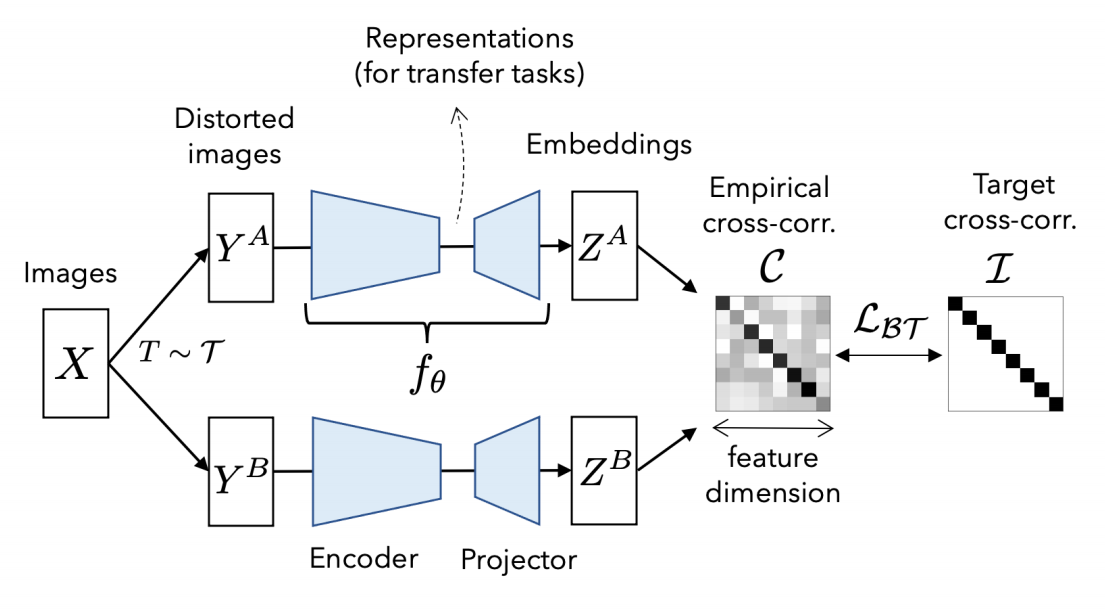注意
您正在阅读 MMSelfSup 0.x 版本的文档,而 MMSelfSup 0.x 版本将会在 2022 年末 开始逐步停止维护。我们建议您及时升级到 MMSelfSup 1.0.0rc 版本,享受由 OpenMMLab 2.0 带来的更多新特性和更佳的性能表现。阅读 MMSelfSup 1.0.0rc 的 发版日志, 代码 和 文档 获取更多信息。
BarlowTwins¶
Abstract¶
Self-supervised learning (SSL) is rapidly closing the gap with supervised methods on large computer vision benchmarks. A successful approach to SSL is to learn embeddings which are invariant to distortions of the input sample. However, a recurring issue with this approach is the existence of trivial constant solutions. Most current methods avoid such solutions by careful implementation details. We propose an objective function that naturally avoids collapse by measuring the cross-correlation matrix between the outputs of two identical networks fed with distorted versions of a sample, and making it as close to the identity matrix as possible. This causes the embedding vectors of distorted versions of a sample to be similar, while minimizing the redundancy between the components of these vectors. The method is called Barlow Twins, owing to neuroscientist H. Barlow’s redundancy-reduction principle applied to a pair of identical networks. Barlow Twins does not require large batches nor asymmetry between the network twins such as a predictor network, gradient stopping, or a moving average on the weight updates. Intriguingly it benefits from very high-dimensional output vectors. Barlow Twins outperforms previous methods on ImageNet for semi-supervised classification in the low-data regime, and is on par with current state of the art for ImageNet classification with a linear classifier head, and for transfer tasks of classification and object detection.

Results and Models¶
Back to model_zoo.md to download models.
In this page, we provide benchmarks as much as possible to evaluate our pre-trained models. If not mentioned, all models are pre-trained on ImageNet-1k dataset.
Classification¶
The classification benchmarks includes 1 downstream task datasets, ImageNet. If not specified, the results are Top-1 (%).
ImageNet Linear Evaluation¶
The Feature1 - Feature5 don’t have the GlobalAveragePooling, the feature map is pooled to the specific dimensions and then follows a Linear layer to do the classification. Please refer to resnet50_mhead_8xb32-steplr-90e.py for details of config.
The AvgPool result is obtained from Linear Evaluation with GlobalAveragePooling. Please refer to resnet50_8xb32-steplr-100e_in1k.py for details of config.
| Self-Supervised Config | Feature1 | Feature2 | Feature3 | Feature4 | Feature5 | AvgPool |
|---|---|---|---|---|---|---|
| barlowtwins_resnet50_8xb256-coslr-300e_in1k | 15.51 | 33.98 | 45.96 | 61.90 | 71.01 | 71.66 |
ImageNet Nearest-Neighbor Classification¶
The results are obtained from the features after GlobalAveragePooling. Here, k=10 to 200 indicates different number of nearest neighbors.
| Self-Supervised Config | k=10 | k=20 | k=100 | k=200 |
|---|---|---|---|---|
| barlowtwins_resnet50_8xb256-coslr-300e_in1k | 63.6 | 63.8 | 62.7 | 61.9 |
Citation¶
@inproceedings{zbontar2021barlow,
title={Barlow twins: Self-supervised learning via redundancy reduction},
author={Zbontar, Jure and Jing, Li and Misra, Ishan and LeCun, Yann and Deny, St{\'e}phane},
booktitle={International Conference on Machine Learning},
year={2021},
}